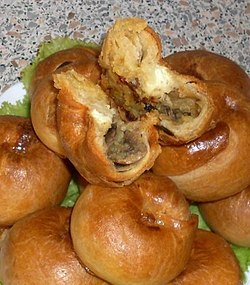food.wikisort.org - Dish
A knish /kəˈnɪʃ/ is a traditional Ashkenazi Jewish[1] snack food consisting of a filling covered with dough that is typically baked or sometimes deep fried.
This article needs additional citations for verification. (May 2021) |
 Knishes with mashed potato and fried onions | |
| Alternative names | Knysh |
|---|---|
| Type | Snack, side dish, finger food |
| Region or state | United States, Israel, other countries with a significant Ashkenazi Jewish population |
| Created by | Jewish communities in Central and Eastern Europe |
| Main ingredients | Mashed potatoes, dough, ground meat, sauerkraut, onions, kasha, cheese |
Knishes are often purchased from street vendors in urban areas with a large Jewish population, sometimes at a hot dog stand, or from a butcher shop. They are still strongly associated with New York City cuisine, possibly because of the iconic Yonah Schimmel's Knish Bakery restaurant,[2] located on the Lower East Side of Manhattan, traditionally a Jewish neighbourhood. Knishes were popularized in North America by Ashkenazi Jewish refugees from the Pale of Settlement (mainly from present-day Belarus, Lithuania, Ukraine, and eastern Poland).[3]
In most traditional versions, the filling is made entirely of mashed potato, kasha (buckwheat groats), or cheese. Other varieties of fillings include beef, chicken, sweet potatoes, black beans, or spinach.
Knishes may be round, rectangular, or square. They may be entirely covered in dough or some of the filling may peek out of the top. Sizes range from those that can be eaten in a single bite hors d'oeuvre to sandwich-sized.
History in the United States

Ashkenazi Jewish immigrants who arrived sometime around 1900 brought knishes to the United States.[4] Knish (קניש) is a Yiddish word of Slavic origin, related to the Ukrainian knysh (книш) and Polish knysz. The ancestor of the knish was a medieval fried vegetable patty or fritter called knysz; eventually it became a stuffed item. In Ukraine, the knysz evolved into a filled yeasted bun, and today is usually sweet rather than savoury; the Ukrainian cousin to the Jewish knish is the pyrizhok (пиріжки). Knishes began to be baked (rather than fried) around the same time that the potato was popularized in Eastern Europe, and the dough wrapper gradually became more like pastry than like bread.[5]
The first knish bakery in America was founded in New York City in 1910.[6] Generally recognized as a food made popular in New York City by Jewish immigrants in the early 20th century, the United States underwent a knish renaissance in the 2000s driven by knish specialty establishments such as Knishes and Dishes in Philadelphia, the Knish Shop in Baltimore, Maryland,[7] Buffalo and Bergen[8] in Washington, DC, or My Mother's Knish,[9] in Westlake Village, California.
In the 20th century, New York City and state politicians portrayed themselves eating knishes to show solidarity with Jewish working-class people. The trend declined after suburbanization and the policies of Ed Koch and Rudy Giuliani that restricted the sale of knishes from food carts.[10]
See also
- Jewish cuisine – Culinary traditions of Jewish communities around the world
- Israeli cuisine – Culinary traditions of Israel
- Turnover – Pastry with a filling on a single piece of dough which has been folded over and sealed
- Yonah Shimmel's Knish Bakery
References
- Wasserman, Tina. "Cooking: The Ultimate Jewish Finger Food". Reform Judaism Magazine. Archived from the original on December 22, 2010. Retrieved 2010-09-14.
- Marks, Gil (2010). The Encyclopedia of Jewish Food. New York: Houghton Mifflin Harcourt. pp. 322–323.
- Silver, Laura (May 6, 2014). Knish: In Search of the Jewish Soul Food. Waltham, Mass.: Brandeis University Press. ISBN 978-1-61168-312-7.
- Smith, Andrew F. (May 2007). The Oxford Companion to American Food and Drink – Google Boeken. ISBN 9780195307962. Retrieved 2013-01-21.
- Marks, Gil (2010). The Encyclopedia of Jewish Food. New York: Houghton Mifflin Harcourt. pp. 322–323.
- (Kugel, Knishes, and Other Tasty Dishes by Nina Yellin, 2001)
- "The Knish Shop, Baltimore". Jewishinbaltimore.com. Retrieved 2013-01-21.
- "Gina Chersevani's Union Market Soda Shop and Bar Will Be Called Buffalo and Bergen | Food & Restaurant News". Washingtonian. 2012-05-24. Retrieved 2013-01-21.
- Alan RichmanPhotograph by Martin O'Neill (8 February 2006). "A Mother's Knishes: Alan Richman". GQ. Retrieved 2013-01-21.
- Silverstein, Andrew (2021-04-07). "Once the staple of New York politics, whatever became of the knish?". Forward. Retrieved 2021-04-15.
External links
На других языках
- [en] Knish
[ru] Кныш
Кныш — характерный для белорусской, южно-русской (Курская губерния)[1] и украинской кухни небольшой круглый пирожок с запечённым внутри (или уложенным на поверхности, между приподнятыми краями) творогом или другой начинкой, например с вареньем или кашей с пассерованым луком со шкварками.Другой контент может иметь иную лицензию. Перед использованием материалов сайта WikiSort.org внимательно изучите правила лицензирования конкретных элементов наполнения сайта.
WikiSort.org - проект по пересортировке и дополнению контента Википедии
